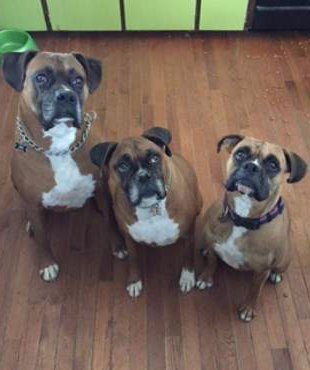Boxer Dog Separation Anxiety

Overview
One of the biggest concerns that owners have is leaving their Boxer home alone and how the puppy or dog responds to that. While there are few dogs that enjoy being by themselves for long periods of time, when a Boxer has separation anxiety, this goes way beyond simply missing his owner. This can be a serious condition that causes both mental stress and is physically wearing on the body.
We know how hard it is to leave the house when you know how rough your Boxer is going to have it. While there will always be times that you have to leave your Boxer home alone and there'll never be times that your dog will be happy to see you leave, there are definitely some things that you can do to make the situation better and to ease your dog's stress level.
Signs and symptoms that Boxers Display when Having Separation Anxiety
Signs of separation anxiety can begin long before an owner even leaves the house; as soon as a Boxer hears the car keys jingle or even sees that an owner is preparing to leave, his nerves can begin to get rattled. Many of the signs will begin after the owner leaves, and is not there to see it however it can often be heard from outside of the house… or neighbors may relay the disturbance.
The most common signs include:
Excessive barking
- This can often be super intense. A dog may bark until he wears himself out; he'll rest and then start up again. Whether a puppy or adult, a Boxer can literally bark for hours until he is hoarse.
Panic
- The thing about separation anxiety is that the stress that a dog feels builds and builds as the time ticks by. While a dog may have slight anxiety at first, as the day goes by he can get worked up into a frenzy. This can make a Boxer literally bounce off the walls. A dog may repeatedly bash his body into walls, claw at the gates and try to escape his confines. This can lead to self-injury and/or damage to the house.
Destructive chewing
- This sort of behavior has nothing to do with chewing due to boredom; this will be uncontrolled chewing
of anything that the dog can mouth. Items are often ripped apart and nothing is off limits; essentially anything that is within reach may be chomped to pieces.
Urination and defecating
- Despite the level of house training
that a dog has, when overwhelming feelings of panic and stress develop when home alone, the Boxer may urinate and defecate with seemingly no control. In addition to this, it can go a step further where the dog then eats his feces (Coprophagia) which has several causes, but separation anxiety is one of them.
Lasting depression
- When a Boxer is totally worn out by a full day of anxiety, it have lasting effects. Some owners think that maybe their dog is mad at them for leaving them alone... but really it's just a matter of a Boxer being so rattled and enduring so much mental struggle that he can appear to be down-in-the-dumps when owners return home. A Boxer may not want to eat, exercise or play. He may have trouble relaxing and even sleeping.
Other signs:
A Boxer may have excess drooling
and/or repetitive behavior such as pacing or circling where the dog repeats an action over and over.
What Causes Separation Anxiety with Boxers
This happens to both genders at the same rate and is not related to how a puppy or dog is treated when with his owners; i.e. paying a lot of attention to a dog or 'spoiling' him will not cause him to be unable to cope when home alone.
The age that a Boxer develops separation anxiety is broad reaching; it can begin at any age at all even if the environment or duration of time left alone is unchanged. In some cases, a Boxer puppy will do just fine but then grow into this. The reason for this is typically because a puppy lives in the moment and his mind often jumps from one thought to the next; cognitive recognition is not fully developed when at a young age. As he matures, he becomes much more aware of time and is better able to realize when he is by himself.
Older senior dogs can develop separation anxiety as well. This is often due to health issues that cause the Boxer to feel vulnerable and is coupled by the fact that an older dog often depends more on his owners for care than his younger counterparts. Another factor is that vision and hearing loss, which is common with senior dogs, can make a Boxer feel antsy; being alone only amplifies those feelings.
How to Help a Boxer with Separation Anxiety
There are several things that you can do to make a Boxer puppy or dog cope better when left home alone. Doing just one of these elements will not often make much of a difference, however when most or all of these are implemented, improvement can be seen within just days.
1) Have the right sized area.
This is really crucial. If the area that a Boxer is kept in is too small, this can make a Boxer feel confined and this is already a breed that is prone to claustrophobia.
However if the area is too large, this is counterproductive as well. When a dog is left alone to roam a large empty house, he often does much worse than when placed in a smaller, safe area that has all his belongings and needs in one space.
Young Boxer puppies
do well in canine portable indoor playpens. Most adult Boxers do well if they are placed in a gated off room such as the kitchen; however do be sure to 'puppy-proof' the room no matter the age of the Boxer. All cabinets must have child-proof locks, trash must be secured, etc. Likewise, a living room or any other room of the house can be gated off/have doors closed.
Do keep in mind that Boxers do best with natural light coming into the room and when in an area that is very familiar; using a basement or other area that is dark or that the dog is not typically in will make things much worse.
2) Have a light source. As stated above, dogs do best when they are in a room that is well-lit by natural sunlight as this can combat feelings of isolation when home alone, however it is always helpful to leave on a lamp or overhead light as well.
Even if you normally return home well before the sun sets, if it happens to rain or even if a storm is close by and the sky becomes cloudy, this can make a house very dark. Dogs that have separation anxiety are often sensitive to light changes; each will have a tipping point…. 70% light… 50%.... each dog will reach a point when they perceive the room to be dark and that can exasperate the feeling of isolation.
3) Keep a radio or TV playing. This is another great tip that can really help dogs with separation anxiety. While you won't be able to trick a Boxer into thinking that he's not alone, hearing pleasant music or voices can have a calming effect. Be careful about which station or channel you choose to make sure that it has appropriate programming all throughout the day; what may be a nice talk show in the morning could turn into a screaming match on Jerry Springer by the afternoon and dogs can relax or tense up simply by the vibe of the noises that they are hearing.
4) Use long-lasting durable treat-release toys.
Some owners skip this one because their Boxer normally does not show any interest. However, once that same dog is home alone, he will focus on what's around him and a good sized Kong filled with kibble and peanut butter can keep a lonely dog occupied for quite a while.
To encourage the use of treat-release toys any meal that would be left out in a bowl for consumption can be replaced with the same amount stuffed into these types of toys.
5) Experiment with a window VS no-window view. Some dogs do best when able to look at the outside world; it can draw their attention to something new and can offer a feeling that they are not as confined as they really are. However, for others, this may be a situation where every single thing that passes by is a trigger for barking. If your Boxer doesn't do well with windows, you may want to close the shades and curtains. If he does do better with a view, having his area near windows or even sliders can help quite a bit.
6) Give your Boxer a companion toy.
What do all living creatures have in common? A heartbeat. Just hearing this can offer comfort to a dog that is by himself. And you don't have to bring in another dog to offer this. There are toys that are essentially large stuffed animals that emit a soothing heartbeat. Many young puppies will take comfort and look at this as a protector; adults and seniors may 'mother' the toy regardless of gender. Don't be surprised if this becomes your Boxer's new best friend.
7) Offer your Boxer a break. Some dogs do just fine during the first few hours, but as the day wears on, the stress builds until it becomes unbearable. Any unpleasant situation seems worse as the time ticks by… and when a dog has separation anxiety, even a tiny break can give him a 'reset' button. If you can't break away and go home for lunch, you may need to reach out for some help.
Some options are to have a friend, family member, neighbor or even a hired dog walker offer a 30 minute break about halfway through the day. During this time, your Boxer can be taken outside for bathroom needs and then be exercised which allows a healthy release of pent-up energy. Most often, due to a combination of quickly falling levels of adrenaline that happens once the dog has interaction with a person & his isolation ends and the short bout of cardio, a Boxer will take a long nap afterward.
8) Make sure your Boxer's toy collection is up to par.
While your Boxer probably has a zillion toys already, do take note of how many he actually plays with and if enough of them are the right type for when he's home alone. Toys to help with separation anxiety must do 1 or all of these 3 things: Draw in his focus, offer textures and durability that will satisfy chewing urges or be interactive. Toys that are brightly colored, offer several different chewing textures and/or bounce easily when played with can help a lonely dog be entertained.
9) Training.
There are 3 types of training that should be done:
1- Train your Boxer to not pick up on cues that you're leaving.
2- Leave and arrive back home in a way that does not get your dog riled up.
3- Don't allow for negative association with the area that the Boxer stays in.
Canines are remarkably smart. Just about anything that is part of your morning routine before leaving for work is a trigger that can make a Boxer start to feel stressed. This can include making your morning coffee, looking for your keys, putting on your coat, reading the paper while eating breakfast, etc.
Most dogs quickly figure out that when these things happen, they are in for a long day alone. This can be reversed. When you are home, at random times you'll want to grab your keys or do any other task that is normally done in the morning… but then either do not leave or leave for a very short amount of time. When you do leave for these 'practice' runs, vary the amount of time that you're gone… 10 minutes one day, 20 the next.
When you leave, do this in a very casual way. Far too many owners anticipate a Boxer's anxiety and try to soothe the dog before leaving with all sorts of attention and petting. It's best leave in a calm, matter-of-fact way.
Coming home should be a calm event as well. Many owners will rush over to their Boxer and this can cause a burst of confused emotion and well as confirm that the dog was correct in being upset that the owner was away. It's best to enter and take a few minutes to check the mail or get a drink and then approach and release the Boxer. The only exception, of course, would be in the puppy or dog had an urgent bathroom need.
Finally, don't place your Boxer in his spot right before leaving; this is particularly applicable for Boxer puppies that are placed in playpens. It's better to have him there a good 20 minutes before you actually go so that he does not develop negative association with the area. When you are home, have the pup spend some time there so that he sees that it does not always mean that you will be gone.
10) Save time in the morning for interaction.
Ideally, you'll want to allow for at least 30 minute each morning to walk your Boxer, allow for bathroom needs and have quality interaction before leaving. This is easier said than done and most people rush around to get ready for work; however if you can wake up a bit earlier this can go a long way.
Should You Get Another Dog?
In most cases, when a Boxer has another dog with him, this does eliminate the issue of separation anxiety. However, it should be noted that in some cases, both dogs will be unable to cope and/or the dogs may have a period of adjustment in which they are not getting along with each other well enough yet to offer companionship and comfort.
We would never advise someone to take on the huge responsibility of having
more than one Boxer for this reason alone.
Buddy, Amber and Brooklyn
Photo courtesy of owner: Debbie Dawson
However, if you've wanted another dog and have given careful thought to the cost and time involved with having multiple pets, this does often help.
Supplements and Medications
There are some canine calming supplements that have been shown to work to some degree. These will do very little on their own if other methods are not implemented. However those with a Colostrum Calming Complex, L Theanine, and Thiamine (Vitamin B1) can be an additional aide in combating anxiety.
Calming collars with lavender have been found to be of some help, when used in conjunction with toys and other aides.
In some cases of very severe separation anxiety in which nothing helps and the dog is suffering overwhelming stress, it may necessitate medication. Benzodiazepines and tricyclic antidepressants may help a Boxer that does not respond to the changes and methods listed above.


